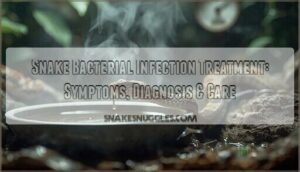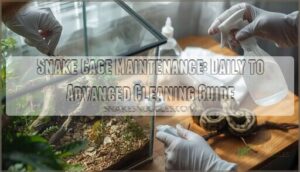This site is supported by our readers. We may earn a commission, at no cost to you, if you purchase through links.

The difference between a minor issue and a life-threatening crisis often comes down to recognizing infection signs within the first 48 hours. Environmental factors like improper temperature gradients or contaminated water dishes create entry points for opportunistic bacteria, turning small wounds into systemic infections.
Understanding how these pathogens invade your snake’s defenses, what symptoms demand immediate attention, and which treatment protocols actually work can mean the difference between a full recovery and permanent damage to your animal’s respiratory system or organs.
Table Of Contents
- Key Takeaways
- Causes of Bacterial Infections in Snakes
- Recognizing Symptoms of Snake Bacterial Infections
- Diagnosis and Identification of Bacterial Infections
- Treatment Options for Snake Bacterial Infections
- Preventing Bacterial Infections in Snakes
- Frequently Asked Questions (FAQs)
- How do you treat infectious stomatitis in snakes?
- How do you treat a snake with antibiotics?
- How do you treat a snake septicemia?
- Are antibiotics effective in preventing a snake bite?
- How do you treat a snake parasite?
- What is bacterial skin infection in snakes?
- How long does bacterial infection treatment typically take?
- Can bacterial infections spread between multiple snakes?
- What are the costs of treating snake infections?
- Are there natural alternatives to antibiotic treatments?
- Conclusion
Key Takeaways
- Bacterial infections in snakes escalate rapidly—catching early symptoms like cloudy eyes, raspy breathing, or skin discoloration within the first 48 hours determines whether you’re facing a treatable condition or irreversible organ damage.
- Environmental failures drive most infections: inadequate temperature control weakens immunity by 30-40%, humidity above 85% breeds scale rot, and contaminated water harbors Aeromonas and Pseudomonas that cause septicemia within 72 hours.
- Effective treatment requires culture-based antibiotic selection because 43% of reptile bacterial strains now resist common drugs like nalidixic acid, and untreated respiratory infections carry 40% mortality within three weeks.
- Prevention centers on three non-negotiable practices: weekly enclosure disinfection with F10SC or 10% bleach, maintaining species-specific temperature gradients and humidity levels, and annual veterinary exams that only 42% of reptile owners currently pursue.
Causes of Bacterial Infections in Snakes
Understanding what causes bacterial infections in your snake is the first step toward prevention. These infections don’t just appear out of nowhere—they develop when specific conditions weaken your snake’s defenses or expose it to harmful bacteria.
Let’s look at the three main culprits behind these infections.
Environmental Stress and Poor Husbandry
At the heart of most bacterial infections lies environmental stress. When your snake’s enclosure falls short of ideal conditions, its immune defenses weaken. Poor husbandry practices greatly increase infection risk:
- Sanitation Practices: Infrequent substrate changes increase bacterial density by 40%
- Temperature Management: Keeping snakes below their preferred range raises infection onset by 30%
- Humidity Control: Levels exceeding 85% promote microbial growth and scale rot
- Enclosure Design: Overcrowding doubles bacterial transmission rates
- Stress Mitigation: Chronic stress increases Salmonella colonization nearly threefold
Maintaining clean enclosures, proper temperature zones, and adequate hiding spots directly aids snake health and hygiene while reducing stress in snakes. Understanding reptile bacterial diseases is vital for effective treatment and prevention.
Contaminated Water and Food Sources
Beyond the enclosure itself, water pollution and food safety pose serious threats to snake health and hygiene. Feeder rodents carry Salmonella in 56% of cases, contaminating feeding surfaces and water bowls. Aeromonas bacteria thrive in stagnant water, causing stomatitis and septicemia within 72 hours of exposure. Preventing infection requires understanding Salmonella risks and taking proper precautions.
| Bacterial Source | Contamination Route | Infection Risk |
|---|---|---|
| Salmonella from prey | Thawed rodents, water bowls | 56% carrier rate |
| Aeromonas hydrophila | Stagnant soaking water | 35% lesion increase |
| Pseudomonas aeruginosa | Unfiltered enclosure water | 62% tank detection |
Aquatic health deteriorates rapidly without proper filtration. Water samples from reptile exhibits showed Pseudomonas in 62% of tanks lacking continuous filtration. Preventing bacterial infections in snakes requires fresh water daily and proper thawing protocols for frozen prey, addressing environmental factors affecting snakes before bacterial contamination becomes systemic.
Traumatic Injuries and Secondary Infections
Physical trauma opens the door for opportunistic bacteria that wouldn’t normally threaten healthy tissue. Bite wounds from cage mates, thermal burns, and scale damage compromise skin integrity, allowing pathogens like Morganella morganii and Aeromonas hydrophila to colonize exposed tissue. Polymicrobial infections occur in 60% of traumatic injuries, demanding immediate wound cleaning and targeted antibiotic therapy to prevent septicemia.
Four Critical Entry Points for Bacterial Invasion:
- Fight wounds – Intraspecies aggression creates punctures teeming with oral bacteria
- Thermal burns – Heat lamp injuries destroy protective epidermis within minutes
- Retained shed – Incomplete ecdysis traps moisture, breeding infection beneath constricted scales
- Substrate abrasions – Rough bedding erodes ventral scales, exposing subcutaneous layers
Without proper wound management, secondary complications escalate rapidly. Infection control becomes increasingly difficult as bacterial resistance develops, especially when trauma response delays exceed six hours post-injury.
Recognizing Symptoms of Snake Bacterial Infections
Catching a bacterial infection early can make all the difference in your snake’s recovery. The signs aren’t always obvious at first, but knowing what to watch for helps you act quickly.
Here’s what symptoms tell you it’s time to call your vet.
Respiratory Distress and Lethargy
Respiratory infections can sneak up on you—over 80% of symptomatic snakes show open-mouth breathing, wheezing, or nasal discharge. You’ll often notice breathing difficulties paired with lethargy and refusal to eat, early warning signs present in roughly 70% of cases.
Bacterial pneumonia demands quick action; untreated respiratory infections can progress to severe respiratory distress or septicemia symptoms, with mortality exceeding 40% within three weeks.
Untreated bacterial pneumonia in snakes can escalate to severe respiratory distress or septicemia, with mortality exceeding 40% within three weeks
Watch for frothy mucus or gurgling sounds—these signal late-stage infection requiring immediate infection control measures.
Skin Discoloration and Wounds
Discolored scales—red patches, brown blotches, or dark blisters—signal bacterial skin infection in 90% of cases. You’re looking at tissue damage that can rapidly progress without snake wound care:
- Scale infections appearing as darkened or necrotic patches, often with crust formation
- Bacterial abscess presenting as raised, purulent lesions beneath the scales
- Ulcerative bacterial dermatitis showing open wounds with necrotic keratin debris
Skin lesions delay shedding by up to 15 days, complicating wound healing and infection control.
Neurological Signs and Severe Illness
When neurological damage strikes, your snake faces a life-threatening crisis. Up to 12% of snakes with severe bacterial infections develop CNS symptoms like head tremors, paralysis, or seizures. Brain infection from bacterial septicemia causes these devastating signs, often alongside severe respiratory distress and systemic infection.
Pythons show neurological symptoms twice as often as boas, with mortality rates reaching 67% despite neurological care interventions.
Diagnosis and Identification of Bacterial Infections
Getting a solid diagnosis isn’t guesswork—your vet needs to see what’s really happening inside your snake. They’ll start with a hands-on exam and run specific tests to pinpoint the exact bacteria causing trouble.
Here’s what that process looks like.
Physical Examination and Symptom Assessment
Your veterinarian’s exam starts with oral inspection, checking for erythema, stomatitis, or plaques that signal infection.
Skin lesions, respiratory checks for labored breathing, and coelomic palpation reveal internal abscesses or fluid buildup.
Neurological signs like head tilting, along with septicemia symptoms in snakes such as petechiae and refusal to eat, point to systemic infection.
Sample collection from wounds confirms snake infection causes through bacterial culture.
Differentiating From Other Snake Diseases
Diagnosing snake diseases isn’t guesswork—it’s about matching test results to what you’re seeing. Gram-stain cytology detects bacterial morphology within 24 hours, while viral inclusions need 72 hours of histopathology.
Bacterial isolation from cultures shows Pseudomonas and Proteus in 72% of infections. However, viral diseases like paramyxovirus produce eosinophilic inclusion bodies absent in bacterial cases.
Fungal infections reveal hyphae under microscopy, and parasite identification shows larvae in tracheal lavage.
Combined PCR panels improve diagnostic testing accuracy by 31%, separating infectious stomatitis in snakes from viral or fungal conditions.
Treatment Options for Snake Bacterial Infections
Once you’ve confirmed a bacterial infection, treatment becomes the next critical step. The approach depends on infection severity, bacterial type, and your snake’s overall condition.
Here’s what you need to know about the main treatment methods.
Antibiotic Therapy and Drug Resistance
Antibiotic therapy targets bacterial infections in snakes, but drug resistance complicates treatment outcomes. Culture and sensitivity testing are essential to select effective medications, as 43.3% of reptile bacterial strains now resist nalidixic acid and kanamycin.
Three essential practices improve antibiotic efficacy:
- Start with enrofloxacin at 5–10 mg/kg every 24 hours for most species
- Switch to narrow-spectrum options once culture results arrive
- Limit treatment to 10 days unless abscess formation persists
Multidrug resistance appears in one-third of cases, making empirical antibiotic treatment risky for septicemia without laboratory confirmation.
Wound Management and Topical Treatments
Daily wound cleaning with dilute chlorhexidine removes debris and prevents secondary infection. Topical antibiotic therapy, such as silver sulfadiazine cream, targets Pseudomonas and other common pathogens.
Silver dressings combined with moisture management through hydrocolloid gels accelerate healing during granulation. Debridement techniques remove necrotic tissue—essential for abscess cases.
Change non-adherent dressings daily, especially in extensive wounds requiring aggressive wound management protocols.
Supportive Care and Hospitalization
When topical treatment alone won’t resolve infection, hospitalization provides the controlled environment your snake needs. You’ll see immediate veterinary attention translate into targeted interventions that home care can’t replicate.
Hospital protocols include:
- Fluid therapy at 10–30 mL/kg/day corrects dehydration and aids kidney function during antibiotic therapy
- Thermal regulation between 26–30°C enhances immune response and drug metabolism
- Nutritional support prevents tissue breakdown through assisted feeding when appetite fails
- Oxygen supplementation maintains tissue repair when respiratory compromise develops
Bloodwork repeats every 72 hours track antibiotic efficacy. Discharge happens only after you see stabilized hydration, consistent feeding, and normal temperature-seeking behavior return.
Preventing Bacterial Infections in Snakes
Prevention is the best defense against bacterial infections in your snake. A few simple practices can dramatically reduce infection risk and keep your reptile healthy.
Let’s look at three critical areas where good husbandry makes all the difference.
Proper Enclosure Cleaning and Disinfection
Weekly enclosure sanitization dramatically reduces bacterial loads—this isn’t optional biosecurity. You’ll need F10SC at 1:250 or a 10% bleach solution with proper contact time. Daily spot cleaning removes feces before pathogens proliferate, while full monthly disinfection manages biofilms. Never mix cleaning products between enclosures; cross-contamination spreads infections faster than you’d expect.
Proper enclosure hygiene directly prevents skin infections in snakes by eliminating bacterial reservoirs. Humidity levels stabilize when you replace soiled substrate regularly, maintaining the microhabitat without moisture spikes that encourage Pseudomonas growth.
| Cleaning Protocols | Disinfectant Safety | Substrate Management |
|---|---|---|
| Daily spot cleaning for feces and urates | F10SC (1:250) safe when dry | Replace paper/sand substrates weekly |
| Weekly deep cleaning recommended | Chlorhexidine (1:30) low irritation | Discard porous bark/wood materials |
| Monthly full disinfection required | 10% bleach: 10-15 min contact time | Remove all substrate during cleaning |
| Rinse thoroughly before reintroduction | Hydrogen peroxide (3%) for porous items | Air-dry furnishings completely |
| Separate tools per enclosure prevent spread | Never mix bleach with ammonia cleaners | Water bowls need daily sanitization |
Optimizing Environmental Conditions
Beyond clean enclosures, your snake’s environmental factors determine whether bacteria thrive or die. Temperature gradients from 72–79°F cool side to 82–90°F basking spot support immune function—snakes below their ideal zone show 40% weaker bacterial resistance. Maintain these parameters consistently:
- Temperature Control: Digital thermometers at three enclosure points prevent fluctuations that compromise immunity
- Humidity Levels: Species-specific ranges (40–75%) prevent Pseudomonas proliferation above 80%
- Ventilation Systems: 5–10 air exchanges hourly reduce respiratory infections by clearing stagnant, bacteria-laden air
- Lighting Balance: 10–12 hour UVB cycles strengthen immune response, cutting skin infections 22%
Proper husbandry practices for snakes aren’t optional—they’re your primary defense against opportunistic pathogens.
Stress Reduction and Routine Veterinary Care
Environmental parameters alone won’t keep your snake healthy—stress reduction and routine vet checkups complete the preventive measures. Chronic stress suppresses immunity for months, inviting bacterial invasion. Minimize handling, provide hiding spots, and maintain quiet environments.
Annual veterinary exams detect infections early through blood work and parasite screening. Only 42% of reptiles receive routine care, yet these visits reduce mortality through owner education on supportive care for snakes and snake enrichment strategies that lower anxiety during veterinary handling.
Frequently Asked Questions (FAQs)
How do you treat infectious stomatitis in snakes?
You’ll need a three-pronged approach: systemic antibiotic treatment for snakes targeting the specific bacteria, oral debridement to remove necrotic tissue under veterinary guidance, and supportive care including proper snake nutrition to aid recovery from infectious stomatitis.
How do you treat a snake with antibiotics?
Like precision farming for livestock, antibiotic therapy for snakes demands customized veterinary guidance.
Your vet determines proper antibiotic dosage based on snake anatomy, species, and infection severity, minimizing bacterial resistance while ensuring effective infection control against resistant organisms.
How do you treat a snake septicemia?
Septicemia requires aggressive veterinary intervention with injectable antibiotic therapy guided by bacterial isolation and susceptibility testing.
You’ll need supportive care including fluid therapy, temperature regulation, and nutritional support—often through assisted feeding or hospitalization for intensive monitoring.
Are antibiotics effective in preventing a snake bite?
Antibiotics don’t prevent snake bites—they treat bacterial infections that develop afterward. Prophylactic use isn’t recommended because infections rarely occur, and routine antibiotics contribute to antibiotic resistance without improving outcomes.
How do you treat a snake parasite?
Treating snake parasites starts with parasite identification through fecal exams or skin scrapings. Your vet will prescribe antiparasitic drugs like fenbendazole for internal worms or ivermectin for mites.
Proper snake hygiene and veterinary guidance guarantee effective treatment and prevent reinfection in your reptile care routine.
What is bacterial skin infection in snakes?
Bacterial skin infection in snakes, also called bacterial dermatitis, develops when bacteria invade damaged skin tissue.
Poor reptile care, contaminated environments, or traumatic injuries create entry points for infection.
Proper infection control and veterinary guidance are essential for treating bacterial skin infections.
How long does bacterial infection treatment typically take?
Your snake’s recovery depends on infection severity and antibiotic efficacy. Mild cases resolve in 7 to 14 days with proper antibiotic treatment and supportive care.
Deep tissue infections require 3 to 4 weeks or longer, especially when antibiotic resistance complicates therapy outcomes.
Can bacterial infections spread between multiple snakes?
Yes, bacterial infections spread between snakes through direct contact, contaminated surfaces, and shared equipment. Pathogens like Salmonella persist in enclosures for weeks, making transmission modes a serious concern. Snake quarantine and biosecurity protocols prevent outbreaks in collections.
What are the costs of treating snake infections?
Costs depend on infection severity and required diagnostics. Veterinary consultation generally costs $75 to $150, with basic tests adding $10 to $
Antibiotic prices range from $10 to $36 per course, though antibiotic resistance may require pricier alternatives.
Treatment expenses escalate quickly—hospitalization rates run $50 to $150 daily, while surgical debridement reaches $500 to $2,
Are there natural alternatives to antibiotic treatments?
Like choosing between a scalpel and salve, natural alternatives to antibiotic therapy exist but require careful consideration. Herbal remedies, probiotic therapy, essential oils, and antimicrobial peptides show promise in laboratory studies against bacterial infections.
Though their effectiveness in treating active snake health crises remains limited compared to conventional antimicrobial therapy, natural supplements work best for preventative care, not acute infections where antibiotic resistance concerns arise.
Conclusion
Your vigilance protects your snake’s health. Your knowledge prevents crises. Your action saves lives. Bacterial infections don’t announce themselves with fanfare—they creep through weakened defenses while you’re adjusting thermostats or scrubbing water bowls.
Snake bacterial infection treatment demands speed, precision, and partnership with an experienced reptile veterinarian. The gap between “I’ll wait and see” and irreversible organ damage closes faster than most keepers realize.
When respiratory sounds change or skin lesions appear, you’re already behind the pathogen’s timeline. Trust your instincts, act decisively, and never underestimate how quickly bacteria exploit vulnerability.
- https://pmc.ncbi.nlm.nih.gov/articles/PMC11066363/
- https://onlinelibrary.wiley.com/doi/10.1155/2024/5213895
- https://vetmed.agriculturejournals.cz/pdfs/vet/2013/12/08.pdf
- https://wvj.science-line.com/attachments/article/78/WVJ%2013(3),%20409-419,%20September%2025,%202023.pdf
- https://www.merckvetmanual.com/multimedia/table/antimicrobial-drugs-used-in-reptiles












